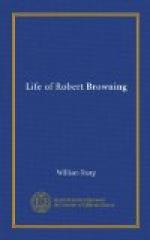There is nothing grand, nothing noble here: at most only a tragic pathos in the fate of the innocent child-wife Pompilia. It is clear, therefore, that the greatness of “The Ring and the Book” must depend even less upon its subject, its motive, than upon its being “an extraordinary feat” in the gymnastics of verse.
In a sense, Browning’s longest work is akin to that of his wife. Both “The Ring and the Book” and “Aurora Leigh” are metrical novels. The one is discursive in episodes and spiritual experiences: the other in intricacies of evidence. But there the parallel ends. If “The Ring and the Book” were deflowered of its blooms of poetry and rendered into a prose narrative, it might interest a barrister “getting up” a criminal case, but it would be much inferior to, say, “The Moonstone”; its author would be insignificant beside the ingenious M. Gaboriau. The extraordinariness of the feat would then be but indifferently commented upon.
As neither its subject, nor its extraordinariness as a feat, nor its method, will withstand a searching examination, we must endeavour to discern if transcendent poetic merit be discoverable in the treatment. To arrive at a just estimate it is needful to free the mind not merely from preconceptions, but from that niggardliness of insight which can perceive only the minor flaws and shortcomings almost inevitable to any vast literary achievement, and be blind to the superb merits. One must prepare oneself to listen to a new musician, with mind and body alert to the novel harmonies, and oblivious of what other musicians have done or refrained from doing.
“The Ring and the Book,” as I have said, was not begun in the year of its imagining.[15] It is necessary to anticipate the biographical narrative, and state that the finding of the parchment-booklet happened in the fourth year of the poet’s widowerhood, for his happy married period of less than fifteen years came to a close in 1861.
[Footnote 15: The title is explained as follows:—“The story of the Franceschini case, as Mr. Browning relates it, forms a circle of evidence to its one central truth; and this circle was constructed in the manner in which the worker in Etruscan gold prepares the ornamental circlet which will be worn as a ring. The pure metal is too soft to bear hammer or file; it must be mixed with alloy to gain the necessary power of resistance. The ring once formed and embossed, the alloy is disengaged, and a pure gold ornament




